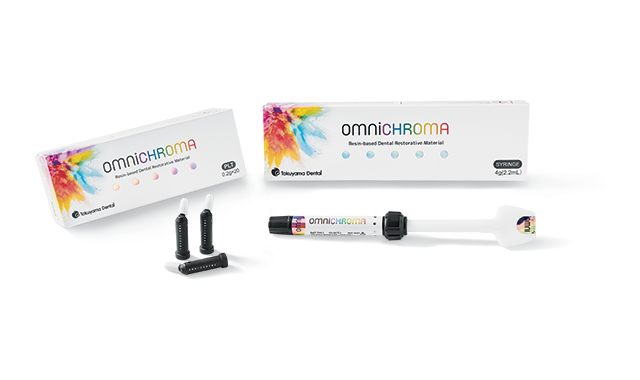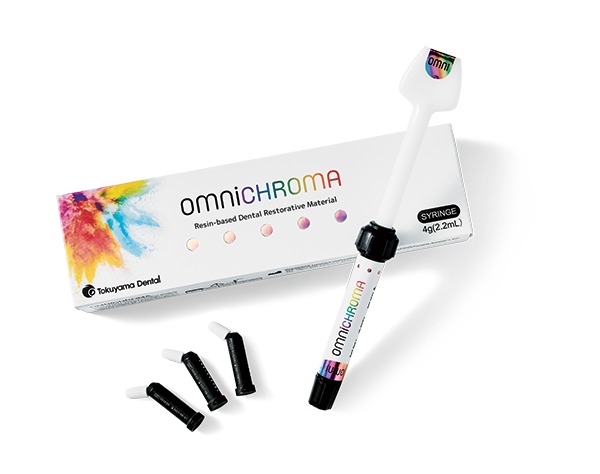A game-changing dental composite
An inside look at the development of OMNICHROMA from Tokuyama Dental America – and what dentists are saying about this material so far.

Zachary Burkett is the product manager overseeing the OMNICHROMA product launch at Tokuyama Dental America. He’s been working with Tokuyama for the last two-and-a-half years, where he started shaping the image that’s now associated with this universal shade-matching composite that was officially launched on Feb. 1. From its undefined beginnings to drafting ads and creating marketing material, defining strategy for the product launch and understanding the technical aspects of OMNICHROMA, Burkett has been at the forefront of what he hopes to see become a product that could revolutionize dentistry.
Can you give a brief explanation of the technology behind OMNICHROMA?
Typical composites rely on dyes and pigments to achieve specific shades and colors, and that’s the way the composite market has been for decades. While composites have definitely gotten better at shade matching over time, there haven’t been many leaps in technology when it comes to color and shading. Even our previous products like Estelite, which was highly regarded for its ability to match shades, required many shades of composite in order to accommodate every patient. What’s cool about OMNICHROMA is that the spherical fillers in the product actually create the color instead of dyes and pigments. As light passes through the composite, the spherical fillers generate red-to-yellow structural color, and that color combines with the reflected color of the patient’s tooth, creating the perfect match. So, OMNICHROMA doesn’t need any dyes or pigments; instead, it just pulls the color from the surrounding tooth.
Read more: Saving valuable time in your dental office with OMNICHROMA
Does the spherical filler technology exist in any other Tokuyama products currently or is this the first?

This is the first product with the technology by itself. That structural color phenomenon was observed with other parts of our products, but it wasn’t controlled enough to use as the main color mechanism, so we still had to rely on dyes and pigments added to our previous composites to match patients’ teeth. Our manufacturing process for OMNICHROMA has been refined to the point where we’re able to control the technology in order to make this product possible.
Do you feel that the technology behind OMNICHROMA can be applied to other aspects of dentistry?
I think so. We do have some exciting developments being worked on right now, which I can’t speak too much about, but there are definitely some other areas where this technology can be applied and where I think it will be beneficial to the entire industry overall. We’re definitely looking at expanding the OMNICHROMA product line beyond the universal composite.
What need spurred Tokuyama to produce a product like OMNICHROMA?
I think part of it was realizing that we had the capability to change something that hadn’t changed for several decades. The process for selecting shades and filling patients’ teeth has pretty much been the same for years, and it was obvious that a simplification there would be a huge benefit to dentists. Filling cavities is kind of their bread-and-butter procedure; it’s the procedure they do the most of every week. So, the fact that that hadn’t changed in so long is kind of remarkable, and we saw an opportunity to streamline something that hasn’t had much streamlining done in a long time in a way that’s pretty extraordinary. This product has the number of shades needed going from about 20 to one. That’s a big reduction and I think a lot of people really appreciate what that means for their practice management, for the actual restoration process itself and just running a tighter business.
Continue to page two to read more...
How can OMNICHROMA help doctors and their practices to be more efficient?
The No. 1 benefit is that there are many shades of teeth from a really light A1 all the way to a D4, and to cover those 16 shades you need 16 different shades of composite. However, you don’t have too many of those really dark patients come in, so you have to keep one syringe on hand for the one patient you see every three years and the composite is going to expire by then. With OMNICHROMA, it’s kind of a first in, first out approach where the same composite you’re using for the patients you’re seeing all the time you’re also using for the one or two patients who are kind of the extreme cases. So, instead of having “just in case” composites, you just have this one and that, I think, is a pretty big benefit to a lot of doctors. Typically, they have to stock multiple shades and keep a wide range of composites to be able to accommodate any patient. The problem with that is that either you don’t have a particular patient’s color composite in stock or you do have it in stock and it ends up going to waste. If you multiply that by the inventory size of any practice, it becomes a pretty big issue with both time and inventory management. This product should hopefully help ease a lot of those issues.
Related reading: 5 mistakes you might be making with composites
How do you think OMNICHROMA will give patients better esthetic outcomes?
Because OMNICHROMA gives doctors one product that matches any patient, patients can be confident that when they go in, no matter what shade of teeth they have, they’re going to walk out with a great-looking restoration. They can be confident that they’re going to have a positive esthetic result. What this product really offers to patients is a faster procedure and a better outcome with that procedure. There’s nothing extra with this product, there’s no extra steps or special equipment that doctors have to have that most of them aren’t already doing to achieve better restorations. Ninety-one percent of people in the United States have some sort of filling, so our product can potentially affect 91 percent of people in the United States.
How have practitioners reacted to OMNICHROMA?
That has actually been the best part for me working on this product. When I first heard of this product, even I found it a little unbelievable. I figured it might be able to do at least some of what Tokuyama said it would do, and that would be fine for half of the cases, and then for the other half it wouldn’t work. But what we’ve seen with so many people using it is the reaction has just been incredible. I actually have doctors calling in to our office or coming in to tell us that they’ve tried OMNICHROMA and they can’t believe how well it works. That’s been really gratifying for me. We’ve had over 1,000 restorations placed for the product and over 94 percent of them are excellent restorations, according to the doctors who have used it. It’s been really exciting to get it into people’s hands and to hear how everything we’ve said about it is true.
What does the future look like for OMNICHROMA?
The future is really bright. Like I said, I can’t speak very much on what our future plans are just yet, but we’re definitely exploring how we can carry this product over into other categories and how this can help dentists in more areas than just the universal composite.
ACTIVA BioACTIVE Bulk Flow Marks Pulpdent’s First Major Product Release in 4 Years
December 12th 2024Next-generation bulk-fill dental restorative raises the standard of care for bulk-fill procedures by providing natural remineralization support, while also overcoming current bulk-fill limitations.